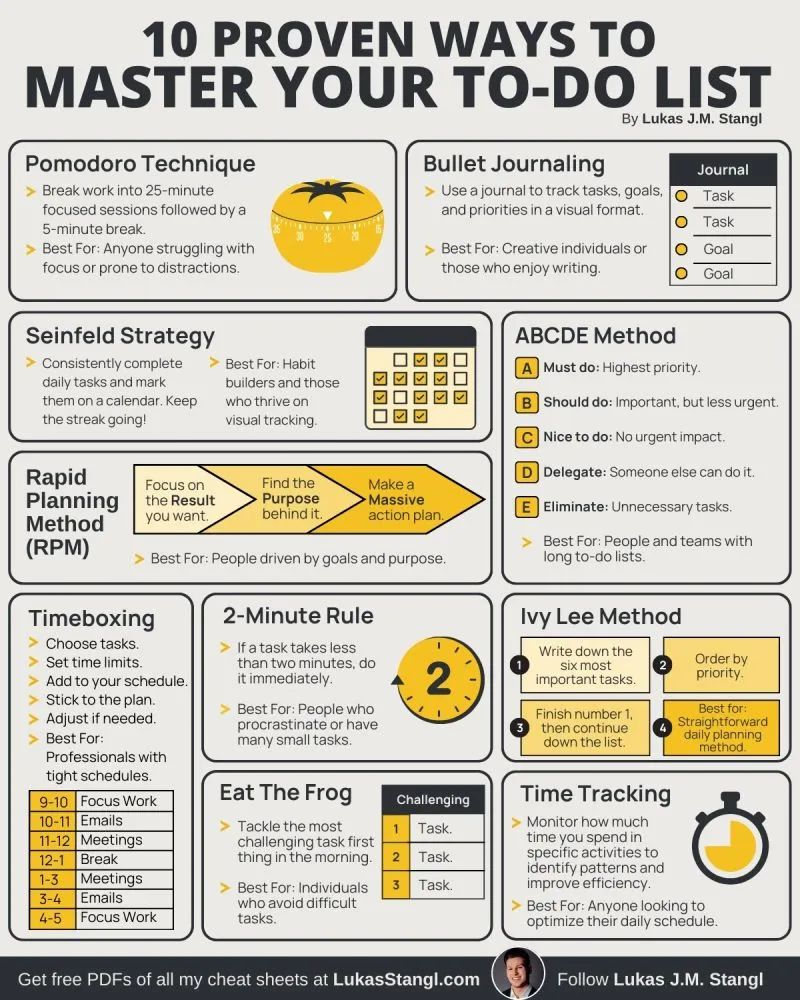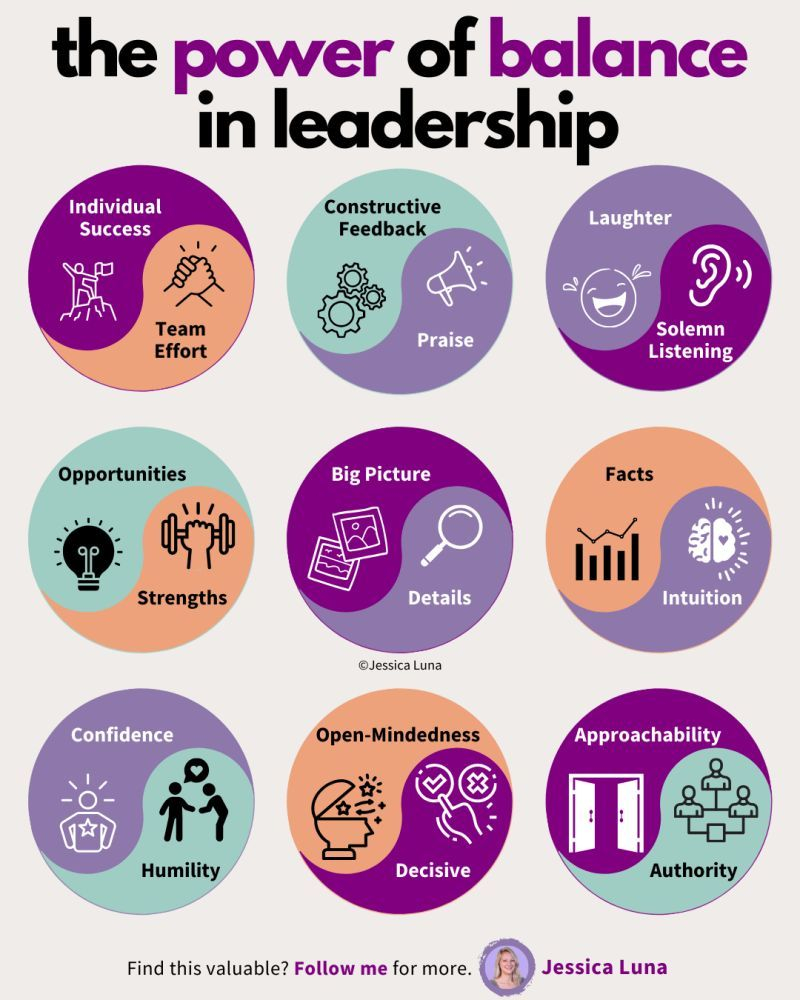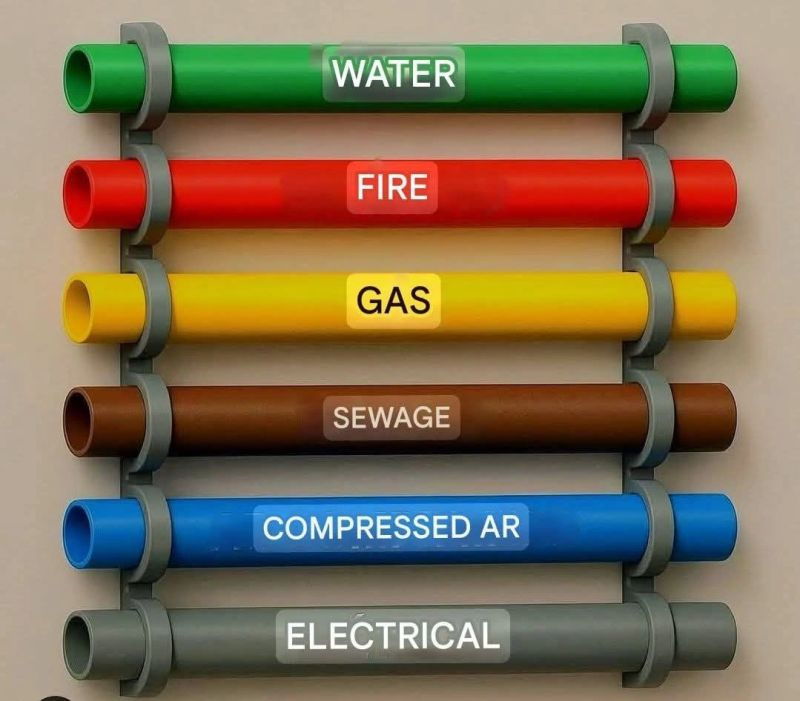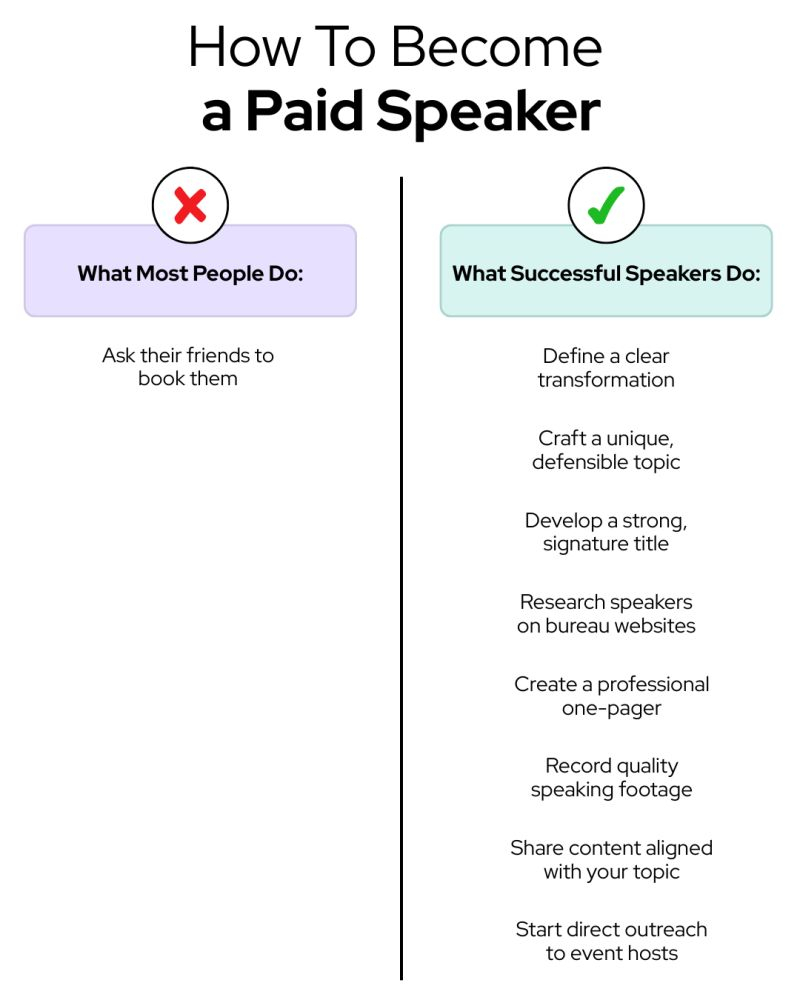"89% of people fail to accomplish their daily tasks.
Here are 10 easy methods from highly productive people.
They help you take control of your tasks.
Own your day with these strategies:
1️⃣ Pomodoro Technique
➥ Break your work into 25-minute focused sprints.
➥ After that, take a 5-minute break.
➥ Rinse and repeat.
2️⃣ Bullet Journaling
➥ Organize your tasks, ideas, and notes all in one place.
➥ This flexible method keeps everything in front of you.
3️⃣ Seinfeld Strategy
➥ Don’t break the chain.
➥ Work on a task every day, and mark it on a calendar.
➥ The goal? Keep the streak alive.
4️⃣ ABCDE Method
➥ Rank tasks from A (urgent and important).
➥ To E (delegate or eliminate).
➥ Work on the A's first.
5️⃣ Rapid Planning Method (RPM)
➥ Tony Robbins’ favorite.
➥ Focus on the outcome you want.
➥ Ask yourself why it really matters.
➥ Build the action plan to achieve it.
6️⃣ Timeboxing
➥ Allocate specific blocks of time for tasks.
➥ No distractions, just pure focus for that period.
7️⃣ 2-Minute Rule
➥ If it takes less than 2 minutes, do it now.
➥ This prevents small tasks from piling up.
8️⃣ Ivy Lee Method
➥ At the end of each day:
➥ Write down the 6 most important tasks for tomorrow.
➥ Tackle them in order of priority.
9️⃣ Eat the Frog
➥ Start with the hardest task first thing in the morning.
➥ After that, everything else will feel easier.
Time Tracking
➥ Use apps to see where your time goes.
➥ Track it, analyze it, and optimize your workflow.
These methods aren’t just about getting things done.
They’re about making sure the right things get done."
______________
Here are 10 easy methods from highly productive people.
They help you take control of your tasks.
Own your day with these strategies:
1️⃣ Pomodoro Technique
➥ Break your work into 25-minute focused sprints.
➥ After that, take a 5-minute break.
➥ Rinse and repeat.
2️⃣ Bullet Journaling
➥ Organize your tasks, ideas, and notes all in one place.
➥ This flexible method keeps everything in front of you.
3️⃣ Seinfeld Strategy
➥ Don’t break the chain.
➥ Work on a task every day, and mark it on a calendar.
➥ The goal? Keep the streak alive.
4️⃣ ABCDE Method
➥ Rank tasks from A (urgent and important).
➥ To E (delegate or eliminate).
➥ Work on the A's first.
5️⃣ Rapid Planning Method (RPM)
➥ Tony Robbins’ favorite.
➥ Focus on the outcome you want.
➥ Ask yourself why it really matters.
➥ Build the action plan to achieve it.
6️⃣ Timeboxing
➥ Allocate specific blocks of time for tasks.
➥ No distractions, just pure focus for that period.
7️⃣ 2-Minute Rule
➥ If it takes less than 2 minutes, do it now.
➥ This prevents small tasks from piling up.
8️⃣ Ivy Lee Method
➥ At the end of each day:
➥ Write down the 6 most important tasks for tomorrow.
➥ Tackle them in order of priority.
9️⃣ Eat the Frog
➥ Start with the hardest task first thing in the morning.
➥ After that, everything else will feel easier.
Time Tracking
➥ Use apps to see where your time goes.
➥ Track it, analyze it, and optimize your workflow.
These methods aren’t just about getting things done.
They’re about making sure the right things get done."
______________
"89% of people fail to accomplish their daily tasks.
Here are 10 easy methods from highly productive people.
They help you take control of your tasks.
Own your day with these strategies:
1️⃣ Pomodoro Technique
➥ Break your work into 25-minute focused sprints.
➥ After that, take a 5-minute break.
➥ Rinse and repeat.
2️⃣ Bullet Journaling
➥ Organize your tasks, ideas, and notes all in one place.
➥ This flexible method keeps everything in front of you.
3️⃣ Seinfeld Strategy
➥ Don’t break the chain.
➥ Work on a task every day, and mark it on a calendar.
➥ The goal? Keep the streak alive.
4️⃣ ABCDE Method
➥ Rank tasks from A (urgent and important).
➥ To E (delegate or eliminate).
➥ Work on the A's first.
5️⃣ Rapid Planning Method (RPM)
➥ Tony Robbins’ favorite.
➥ Focus on the outcome you want.
➥ Ask yourself why it really matters.
➥ Build the action plan to achieve it.
6️⃣ Timeboxing
➥ Allocate specific blocks of time for tasks.
➥ No distractions, just pure focus for that period.
7️⃣ 2-Minute Rule
➥ If it takes less than 2 minutes, do it now.
➥ This prevents small tasks from piling up.
8️⃣ Ivy Lee Method
➥ At the end of each day:
➥ Write down the 6 most important tasks for tomorrow.
➥ Tackle them in order of priority.
9️⃣ Eat the Frog
➥ Start with the hardest task first thing in the morning.
➥ After that, everything else will feel easier.
🔟 Time Tracking
➥ Use apps to see where your time goes.
➥ Track it, analyze it, and optimize your workflow.
These methods aren’t just about getting things done.
They’re about making sure the right things get done."
______________
0 Comments
0 Shares
529 Views
0 Reviews








